26 Strategies To Boost and Improve Internal Communication

Perpetual
Speaker
21 Sept 2023

Communication isn’t always easy.
Getting the right message to the right people in the right place at the right time with the right tone – it’s a lot.
Many large organizations spend big on their public image and messaging. But often, internal communications don’t get the same level of attention – even though they’re just as vital.
This post is for leaders and comms professionals at any organization that could benefit from some internal communication improvements. We’re giving you 26 proven, simple ways to improve internal communication in the workplace.
These are simple internal communication best practices that you can easily implement for fast results.
But before we jump into those strategies, let’s talk about why internal communication is so important in the first place.
Why is it important to improve internal communication?
Improving internal comms matters because the quality of communication In the workplace is one measure of an organization’s health.
But quality communication has an effect on the bottom line, too. The Harris Poll (in collaboration with Grammarly) found that poor communication and miscommunications cost an average of $12,506 per employee – every single year.
Despite this data, companies still view internal communications as an expense rather than a potential revenue driver. This approach will ultimately lead to employee-related problems, such as low engagement and retention and more challenging employee acquisition.
Fortunately, there are many approaches to improving internal communications strategies.
Below, you’ll see 26 different methods (each of which follows internal communication best practices) that can help you implement and build your company’s internal communications plan.
26 ways to improve internal communication in your workplace
Since internal comms are so vitally important for business success, business leaders need to know how to implement them effectively in their workplaces.
The list below will provide insightful tips and inspiration for improving internal communication, resulting in enhanced company culture, productivity, morale, and overall effectiveness.
1. Start with the leadership team
Everyone wants open and communicative colleagues, but how would you rate your communication skills?
Your role as a leader is to establish a culture of open internal communication in the workplace and set a standard of internal communication best practices within your company. That’s why examining the way you communicate is a great place to start.
So keep in mind that improving internal communications starts with you, and that evaluating your own communication skills will help your colleagues follow your lead.
2. Check in with your employees
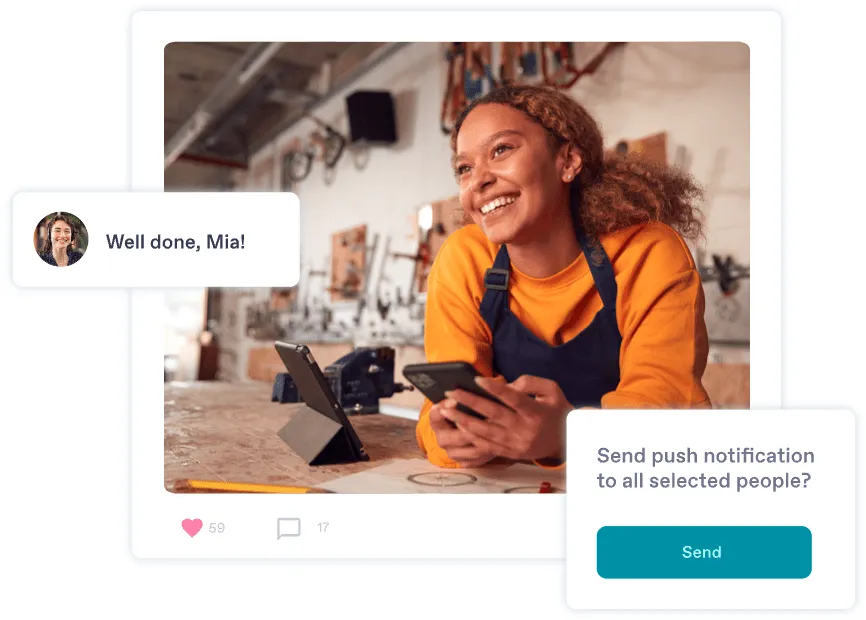
Regularly getting in touch with your employees is essential to improving employee communication. A great way to start is by planning in-person or online meetings every few weeks to discuss projects, personal issues, or the organization.
Encourage your employees to share their thoughts and opinions. Do they have some recommendations or complaints? What do they think about the company and the work given to them?
If your staff members know that you respect and value their opinions, you’ll improve internal communication and see massive improvements in your company culture.
3. Learn more about your employees
No two people are alike, and meaningful conversation can mean different things to different people.
Nothing will make your team feel more valued and appreciated than you reaching out in person to determine their needs. And acting on those needs is always a plus for employee engagement and morale.
Ask yourself, how do your staff like to communicate? Do they prefer to chat on their smartphones, receive surveys and newsletters, or have face-to-face communication?
Knowing all the nuances of how your company communicates will significantly improve internal communication and keep employees engaged and informed.
4. Ask for feedback on your internal communication strategy
Next, gather feedback from colleagues on how you and your organization could improve communication in the workplace. Collecting this information doesn’t require a formal survey, but it’s a good idea to document it somewhere.
You can use this feedback to develop unconventional ways to facilitate communication through continuous improvement. And an effective internal communication strategy should constantly review those channels against employee engagement to improve internal communication.5. Create a consistent internal comms plan with your team
5. Create a consistent internal comms plan with your team

One weakness some organizations encounter is an inconsistent approach to internal communication. Every leader or comms professional does things just a little bit differently, and it’s easy for stuff to start falling through the cracks.
As a start, ask yourself how many channels your organization uses. Communication methods like email, team chats, video conferencing platforms, and even the telephone all impact employee communication in the workplace.
However, some of these communication channels are likely to be more efficient than others. For instance, email is not the best for two-way communication. That’s why some companies favor social intranets and collaboration tools.
Create a list of your current internal communication tools and honestly evaluate which ones you think are working and which ones need to be updated or removed.
When crafting your internal comms plan, look for tools that allow you to be diverse in your communication methods and make it easy to experiment with different formats. You also want to create a plan that provides consistency in employer branding, company goals, company culture, and communications tools.
6. Create an ‘open door’ policy
Communicating internally with your employees encourages them to feel comfortable bringing issues to your attention whenever necessary. It’s a great way to engage employees and improve communication in the workplace while making yourself appear more approachable.
However, your door could be wide open and still have no one coming through it. So don’t be shy about inviting people to come in or leading by example by getting up from your desk and making your own rounds.
Of course, if you’re working remotely or in a hybrid office, your open-door policy might need to look a little different. (Keeping your door open doesn’t do much good if the only thing walking in is your dog!)
Another way to do this (one that works well for remote teams and hybrid workplaces) is to implement regular scheduled communication. This helps empower your employees, builds bonds of trust, and creates a culture of free and open communication in your organization.
Take time to meet with your staff as often as you feel necessary. Invite them to group discussions about projects, tasks, and the situation in your company as a whole.
7. Try company-wide standups
Another great option that serves a practical purpose is daily standup meetings. This form of operational communications (one of five categories of internal communication) keeps your leadership team and the people they lead current on the status of their tasks, projects, and initiatives.
Standup meetings can be held in person or via video conferencing if you have remote workers, and they can be as short as 10 minutes. For larger organizations, standups might be limited to departments or teams.
If you have the privilege of your entire team being in one time zone, try scheduling your meetings at the same time every day, ideally at the beginning or end of working hours. But if your staff are all over the world, try finding a time that works for all remote workers.
8. Encourage more regular conversations
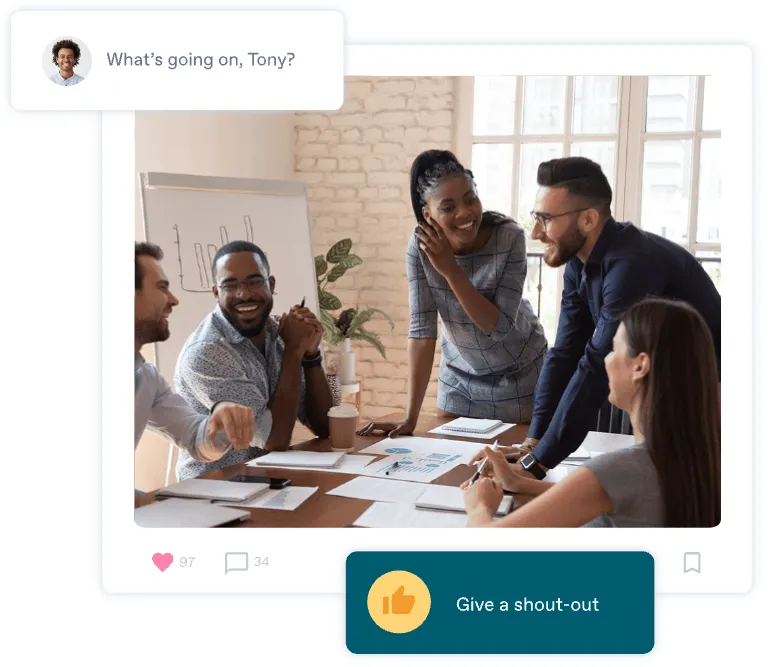
As a communicator, you already know how important it is to build productive bonds. But that’s hard to do if all you ever talk about is work.
A vital aspect of every relationship is engaging in normal, everyday non-work conversation. If your employees feel like having casual discussions or debates during the workday, you should allow them to do so, within reason.
The biggest reason to encourage informal communication is that your most lively, engaging ideas can come from it. Great ideas often come from the heart and soul of the organization – its employees.
9. Make internal knowledge easily available
Not all communication is two-way or one-way direct communication. Information and internal knowledge is also a form of communication – but only when people can find what they need.
No matter what industry you’re in, document management and knowledge sharing are essential daily tasks. That’s why you need your employees to be able to find files, photos, documents, and answers easily.
An effective social intranet is a great way to centralize all this information and put it at the fingertips of your entire organization. To improve internal communications, start with how your staff finds relevant information.
10. Use a powerful social intranet
In recent years, more and more businesses have discovered how powerful social media is for engaging with customers. But fewer businesses understand that they can leverage a similar social power, a social intranet, to improve internal communication, grow engagement, and keep employees up to date.
Encourage your employees to like, comment, and share interesting posts about your organization and company values. But don’t limit this activity to external social networks like LinkedIn. Leverage those same benefits in your own social intranet, a central location for information sharing, peer recognition, company comms, and more.
With Workvivo’s social intranet, you can use social tools to reap the benefits of social media in your business’s daily activity.
Allow employees to share their thoughts and interests to create meaningful, work-related conversations. It’s a great way to match relationship-building to your company goals.
Workvivo is a better social intranet built for modern businesses, including remote and hybrid teams. See Workvivo’s social intranet in action.
11. Use an employee app to enhance company culture
If you’re a large organization with national or even global locations encompassing a wide variety of roles, establishing a cohesive company culture can be difficult. It might feel like a challenge to get those who aren’t in the central office or headquarters to feel engaged and in communication with the rest of the workplace.
If this is you, it means that a huge part of your staff may feel alienated from your company culture – and might not be factored in fully to your internal comms.
But nearly everyone has a smartphone, and with employee apps like Workvivo, you can keep your entire workforce connected, whether they’re on the frontlines, behind a desk, or working remotely.
Using an employee app can ensure that even frontline employees feel connected to the wider organization, and doing so can improve both internal communication and company culture.
12. Organize your documents for effective internal communication
If finding information in your departments is always a challenge, then you aren’t maintaining internal communication best practices.
Use your intranet to organize your teams and the people and information within those teams to make your employees’ work easier. You can turn it into the go-to place for finding and accessing data.
Heads of departments can also instantly communicate with members by sharing documents and sending updates through an internal notification system.
As a result, management can easily contact members, and members can access documents and information on demand. This is particularly helpful for new employees. When they can find everything they need easily, they can hit the ground running.
13. Create internal language within your company
Sometimes, the best way to improve employee engagement and communication in the workplace is to create an internal language. It can include acronyms used every day to describe aspects of business or made-up words inspired by your company’s inside jokes.
It’s a fun exercise that will keep things interesting throughout the week. It will also improve communications and make them more fun and free-flowing.
14. Focus on employee engagement
You can have the clearest, most perfectly crafted internal communication the world has ever seen. But it’s still useless if your people never see it.
Employee engagement is the degree to which people in an organization stay aware, up to date, and on board with the policies, culture, or communication of that organization. When employees disengage, they stop reading memos. They stop pursuing information that isn’t handed to them. And eventually, they stop performing.
One way to address shortcomings in your internal communications strategy is to think of them in terms of engagement. Do people want to read your message? Can they find it? Is there any accountability for failing to read it?
When you channel your internal comms through a platform built for employee engagement, you get more effective communication, plain and simple.
See how Workvivo transforms employee engagement.
15. Openly reward your employees
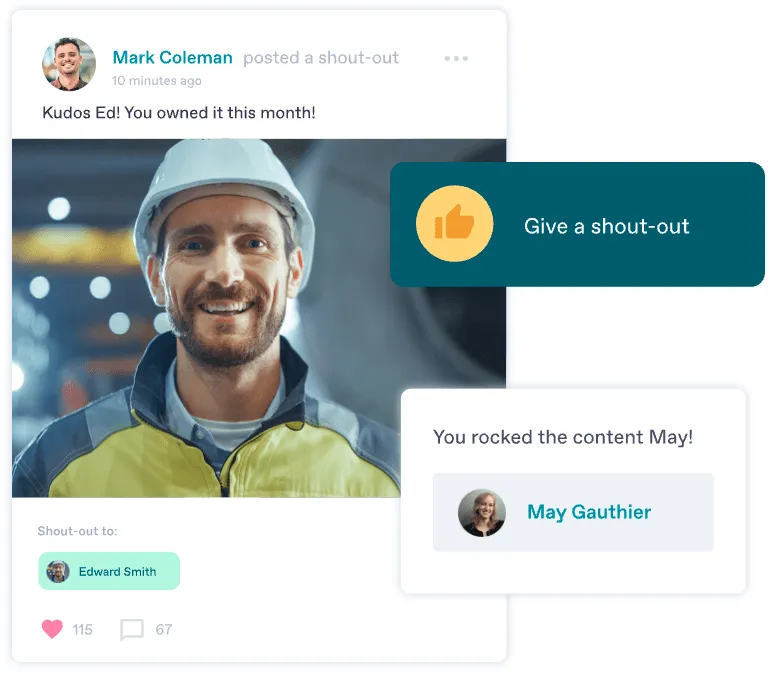
When expectations are set, engaged employees generally strive to meet them. You should recognize your employees’ efforts when they go above and beyond on a task and ensure that recognition is made public.
This matters for two reasons:
- It acknowledges and rewards exemplary effort. We, as humans, like to receive recognition, especially when working toward a goal. Receiving one-to-one recognition from your manager is nice – receiving it in front of your colleagues, even your entire company, is even better!
- It sets an example for your entire organization and gives employees something to aspire to.
There are several ways you can reward your staff. If your internal communication platform engages employees with gamification, you can use that to publicly reward employee performance.
Rewarding your employees publicly will improve their morale. As a result, engagement on your social intranet (and thus internal comms) will significantly improve because your employees will be excited to share their wins.
16. Make every employee communication matter
It’s vital for leaders to consider the importance of the message or update every time they share information they expect employees to read.
In a way, this is internal comms 101. If you flood employees with noise and irrelevant content, they’ll learn to tune you out. But if every communication from someone at your level of leadership is packed with meaningful information, you’re going to get better engagement and better view rates.
17. Allow your employees to recharge
Working long hours is exhausting, both physically and mentally. Just about everyone has experienced burnout at some point. Needless to say, it’s difficult to communicate with others efficiently when you’re burnt out.
So our advice: allow your employees to take those much-needed breaks. Whether this means longer lunches or the occasional day off, it will pay off in the end.
Bonus tip: to keep boosting employee engagement via your social intranet, encourage employees to share with their colleagues how they’ve used their time off. It’s a great way to foster healthy relationship-building and boost team morale.
18. Improve manager-employee relationships
In some organizations, managers and employees work closely with each other. However, this isn’t the case for every business. It’s not uncommon for employees to have quick, impersonal interactions with their managers and never get to know them on a personal level.
Encouraging better collaboration between employees and managers allows people to be more open and communicate freely.
This is a tricky thing to get right, and it’ll take more than a single tactic to reach every employee and personality type. If you’re looking for additional ways to build stronger manager-employee relationships, check out the manager-employee relationship advice Forbes collected from 14 experts.
19. Stay away from top-down communication
Many businesses use a top-down approach to communication. It’s been a classic method for decades. This type of communication in the workplace gives you more control over your message but won’t serve your employees in the long term.
Instead, you should establish an open line of communication for employees. If you do, you’ll see your internal communication improve almost instantly.
Remember: communication in the modern workplace should always be a two-way street.
20. Encourage content creation in your communication channels
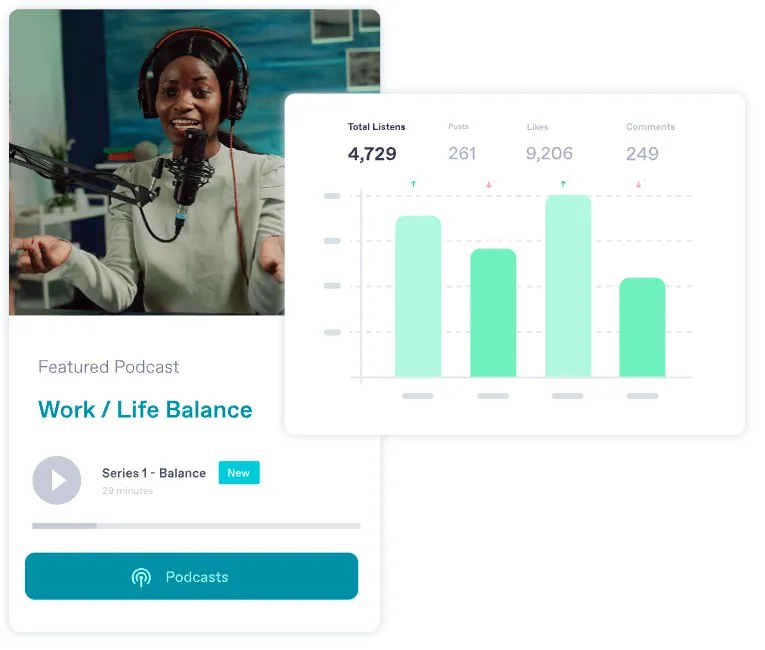
Empowering your employees with intranet tools will allow them to create and share content within your organization. This will help them develop a voice in the company and skyrocket their engagement.
Content creation can massively improve internal communications and can take many forms, including:
- Blogs
- Thought pieces
- Podcasts
- Video blogs
- Polls
- Posts
Plus, employees can interact with their colleagues’ posts, which is another effective method for creating productive discussions. Not to mention, it will strengthen knowledge sharing for each group in your organization.
21. Start conducting stay interviews
A stay interview is a one-on-one meeting where managers or leaders chat with their employees to figure out what’s working and what’s not working in their jobs and the company as a whole.
The goal is to improve internal communications and discover what problems need fixing – before an employee is doing an exit interview on the way out the door.
Believe it or not, a stay interview is a great way to measure your organization’s success and could answer some of the problems your organization is facing. The best ideas are often inside the minds of your employees.
22. Make an effort with shy employees
Some people may be less likely to speak up in meetings or let their personalities shine through in social settings – but they are just as valuable as their more outspoken colleagues. One smart approach is to identify and reach out to quieter members one-on-one and give them an opportunity to share their ideas.
In addition, as a part of your internal communications plan, every employee should go through an onboarding process in which they get acquainted with all team members. This will help them break the ice with everyone and feel more comfortable in their role and on their team.
23. Schedule video conferences for remote employees
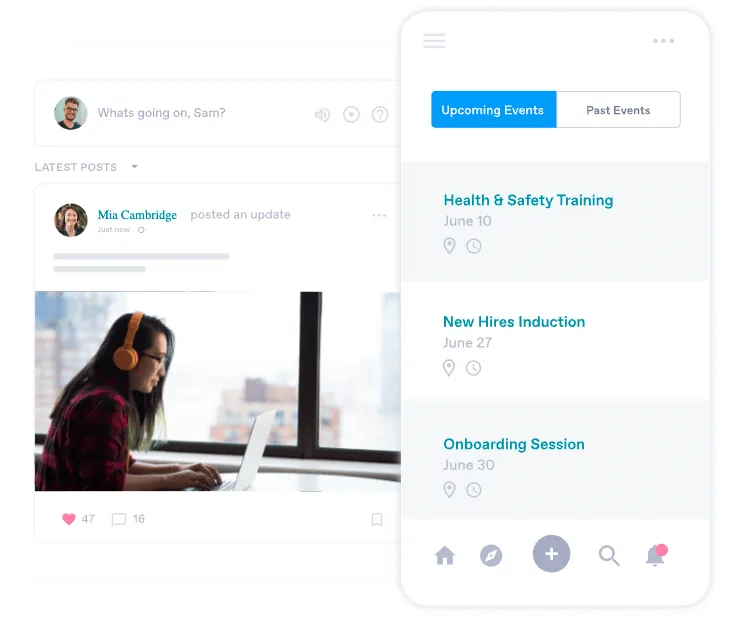
Managing remote employees can be hard, especially when it comes to building relationships. One solution to this problem is video conferencing. It’s the best way to meet with remote employees face to face.
If you manage remote employees (or are one yourself), consider scheduling weekly video meetings to discuss ideas and issues or participate in other team-building activities. This is a great way to get to know the people you work with and keep up to date with what they’re working on.
Plus, it sets the right tone for your workplace’s internal communications – everyone should have a voice and a face!
24. Celebrate personal occasions and successes
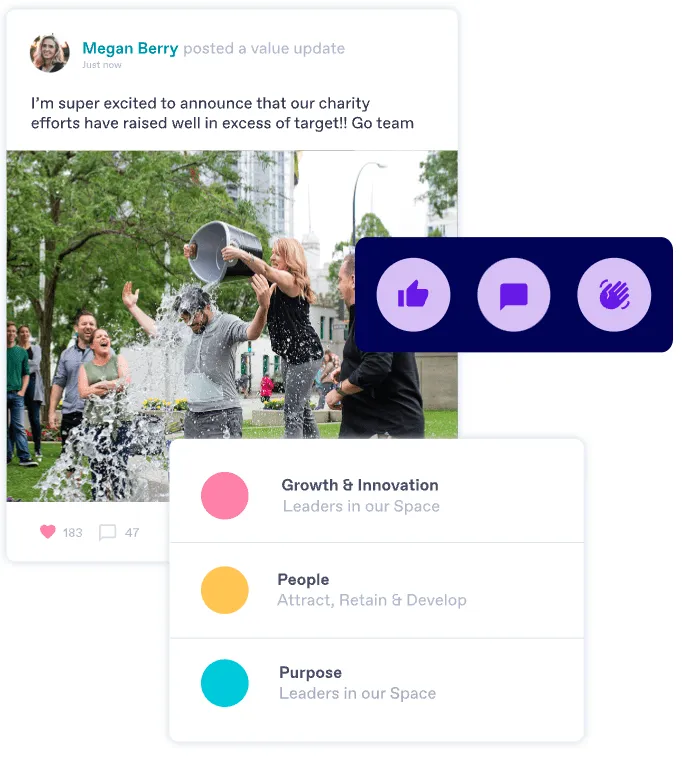
We talked about how a comfortable working environment (one where people are at ease communicating with others) improves internal communications. The key is to treat your employees like the real people they are.
Announcing birthdays or work anniversaries is a small, easy-to-do gesture that builds a people-oriented community, making everyone feel valued and appreciated. As part of your internal communications plan, make an effort to schedule comms about work anniversaries and employee birthdays beforehand.
It’s also great to encourage social sharing if an employee has had a personal achievement, like a new home, a wedding, a baby, or another accomplishment. Just be sure to let the employee do the sharing! Some employees might not want every personal update shared with the team.
25. Welcome questions and open discussions
Questions are one of the most vital components of effective communication in the workplace.
Just as you likely feel comfortable asking questions to any team member, your employees should feel comfortable doing the same. Employees at all levels, whether new employees, managers, executives, or even stakeholders, should be approachable.
Instill that ‘questions welcome’ mindset in your company by encouraging two-way communication and asking your employees whether they have questions for you.
Bonus tip: Set the tone by keeping those questions and the ensuing discussions open, honest, and respectful.
26. Use surveys for a data-driven communication policy
Every employee is different, regardless of the type of organization you run.
Perhaps the best way to improve internal communications in the workplace is to run a survey and ask people how they want to communicate.
This is super helpful because it’s a way to ask direct questions and get all the information you need. Also, your team will feel more valued and appreciated, boosting employee morale. You can use this data to run analytics and reach data-driven conclusions about your internal comms policy.
However, some employees may find surveys boring. That’s why Workvivo gives you the opportunity to create short and fun polls that get people engaged and don’t feel like a drag.
Find out how Workvivo can improve your internal comms
Workvivo is one of the smartest, most powerful ways for mid-market and large organizations to improve company culture through better communication in the workplace.
Over one million employees connect through Workvivo daily, and organizations using Workvivo are improving employee engagement, satisfaction, and retention.It’s the single most powerful change you can make to improve internal communication. If you’d like to hear more about how Workvivo can work for your organization, book a demo today.

